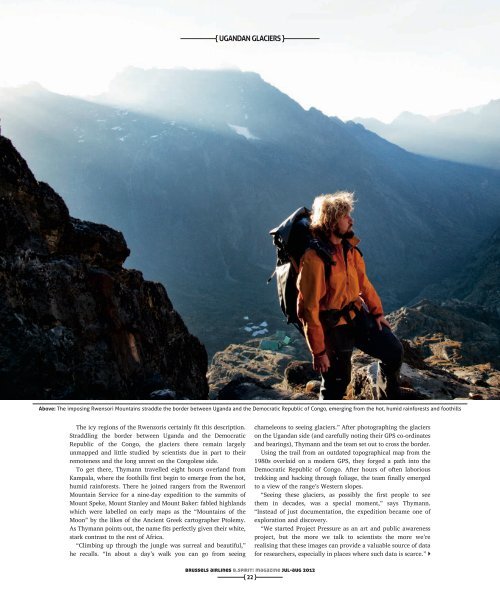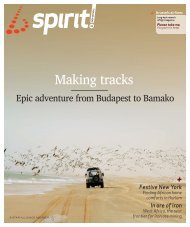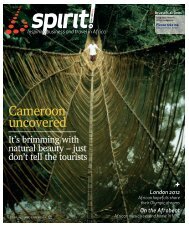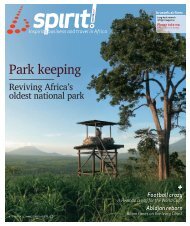july-2012
july-2012
july-2012
Create successful ePaper yourself
Turn your PDF publications into a flip-book with our unique Google optimized e-Paper software.
The icy regions of the Rwenzoris certainly fit this description.<br />
Straddling the border between Uganda and the Democratic<br />
Republic of the Congo, the glaciers there remain largely<br />
unmapped and little studied by scientists due in part to their<br />
remoteness and the long unrest on the Congolese side.<br />
To get there, Thymann travelled eight hours overland from<br />
Kampala, where the foothills first begin to emerge from the hot,<br />
humid rainforests. There he joined rangers from the Rwenzori<br />
Mountain Service for a nine-day expedition to the summits of<br />
Mount Speke, Mount Stanley and Mount Baker: fabled highlands<br />
which were labelled on early maps as the “Mountains of the<br />
Moon” by the likes of the Ancient Greek cartographer Ptolemy.<br />
As Thymann points out, the name fits perfectly given their white,<br />
stark contrast to the rest of Africa.<br />
“Climbing up through the jungle was surreal and beautiful,”<br />
he recalls. “In about a day’s walk you can go from seeing<br />
{ UGANDAN GLACIERS }<br />
Above: The imposing Rwensori Mountains straddle the border between Uganda and the Democratic Republic of Congo, emerging from the hot, humid rainforests and foothills<br />
brussels airlines b.spirit! magazine jul-aug <br />
{ 22 }<br />
chameleons to seeing glaciers.” After photographing the glaciers<br />
on the Ugandan side (and carefully noting their GPS co-ordinates<br />
and bearings), Thymann and the team set out to cross the border.<br />
Using the trail from an outdated topographical map from the<br />
1980s overlaid on a modern GPS, they forged a path into the<br />
Democratic Republic of Congo. After hours of often laborious<br />
trekking and hacking through foliage, the team finally emerged<br />
to a view of the range’s Western slopes.<br />
“Seeing these glaciers, as possibly the first people to see<br />
them in decades, was a special moment,” says Thymann.<br />
“Instead of just documentation, the expedition became one of<br />
exploration and discovery.<br />
“We started Project Pressure as an art and public awareness<br />
project, but the more we talk to scientists the more we’re<br />
realising that these images can provide a valuable source of data<br />
for researchers, especially in places where such data is scarce.”











